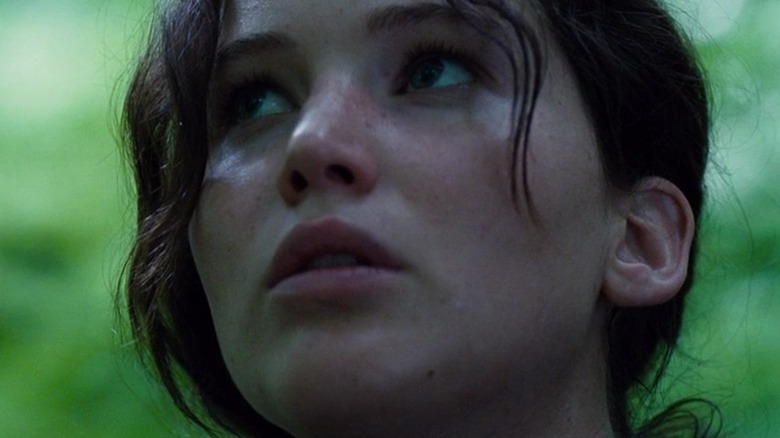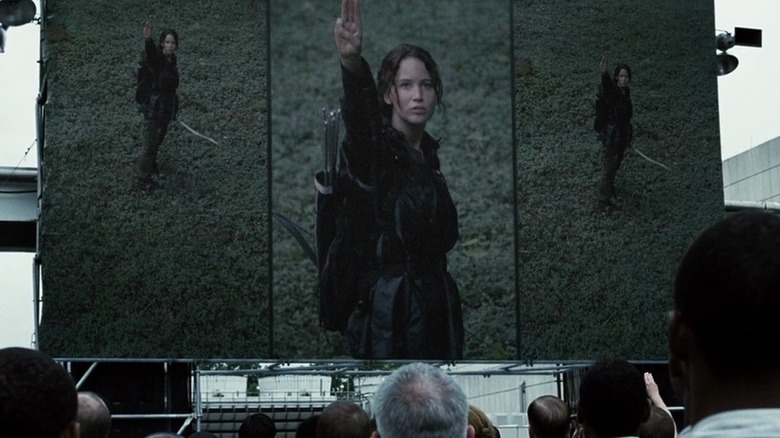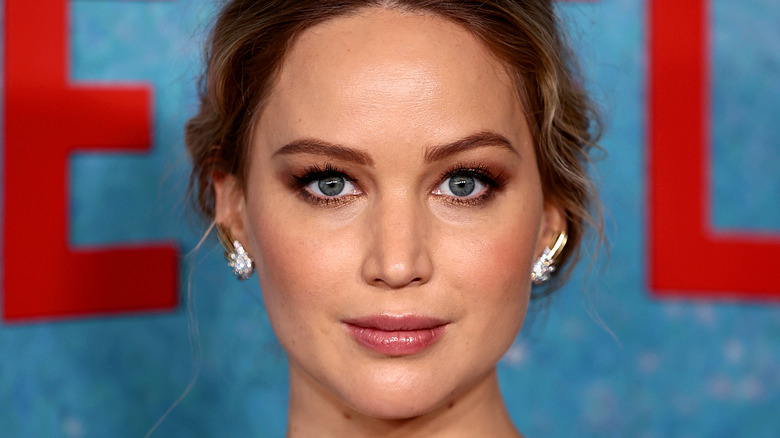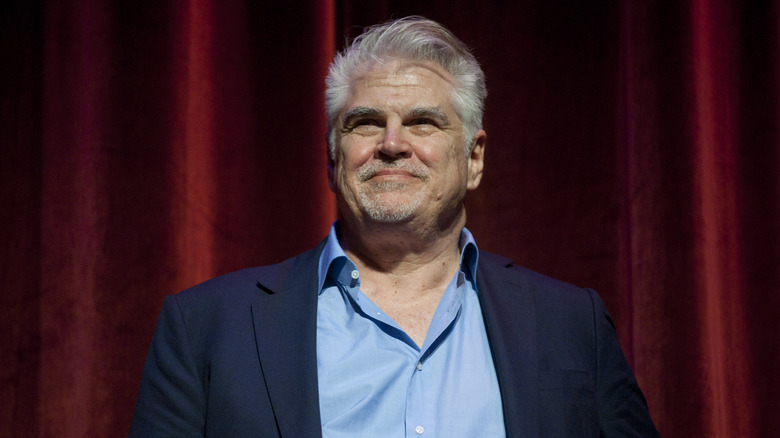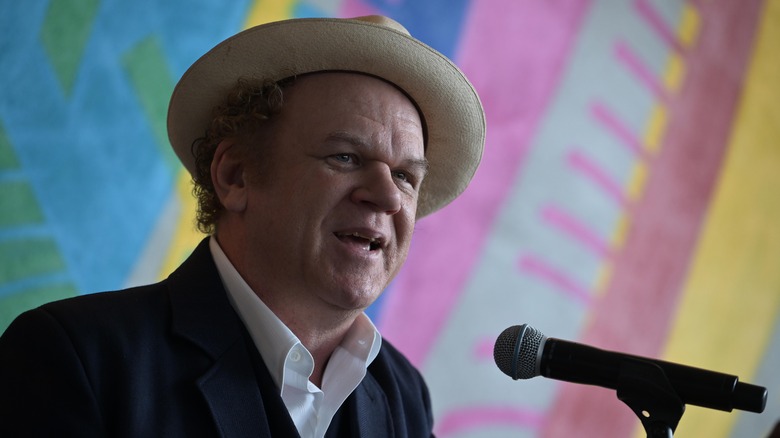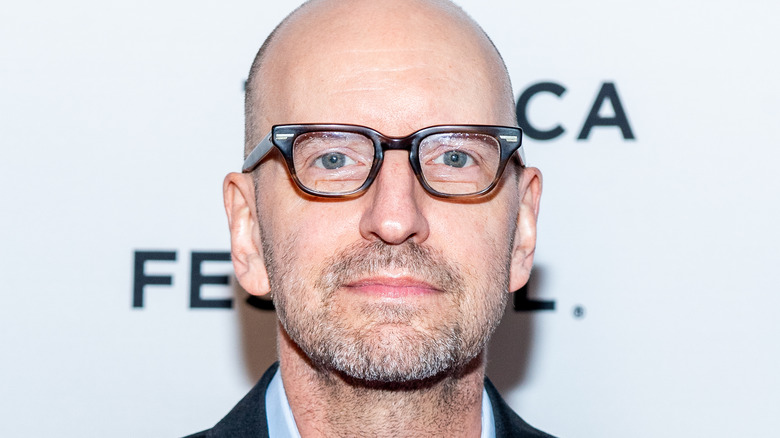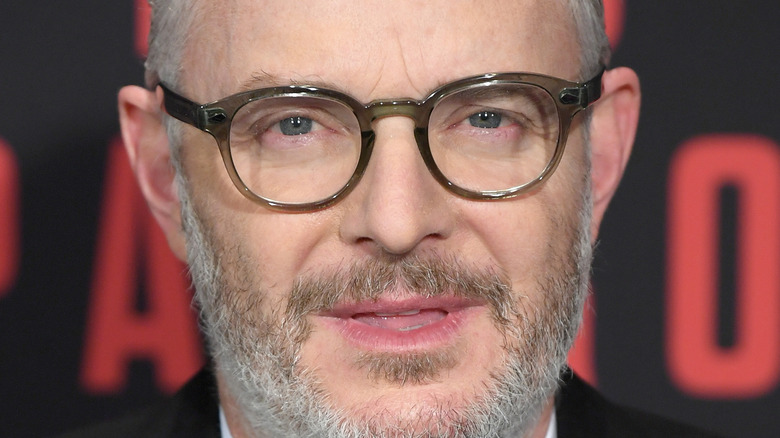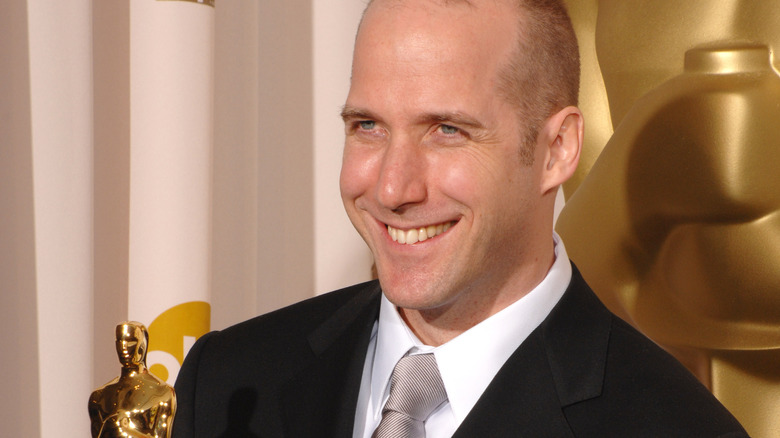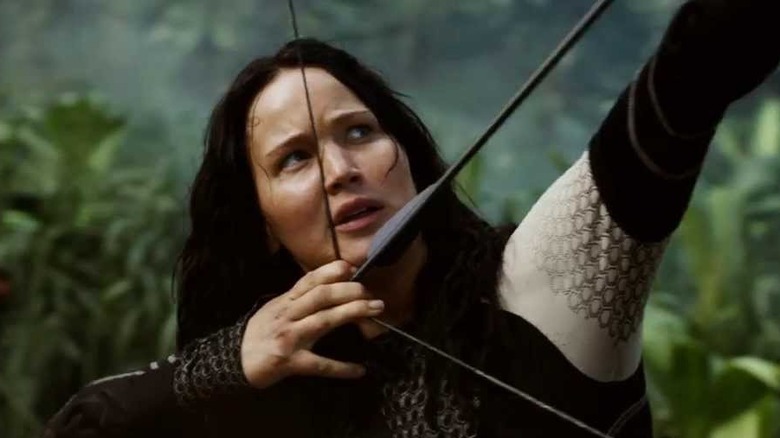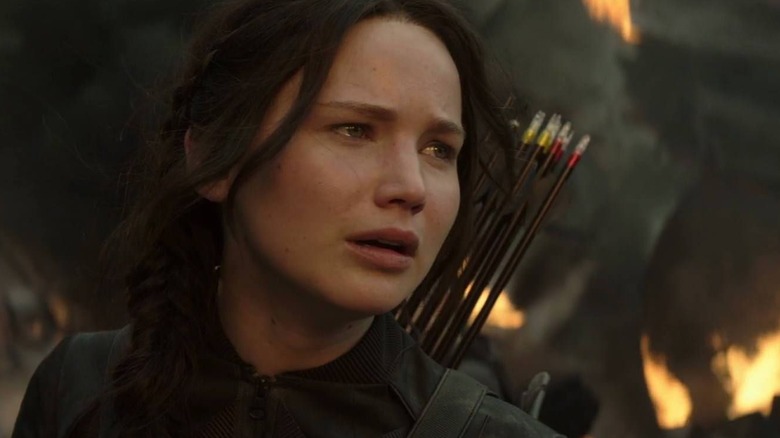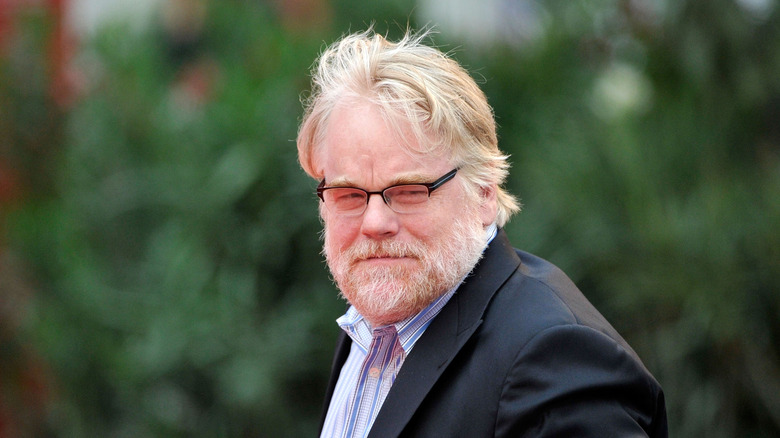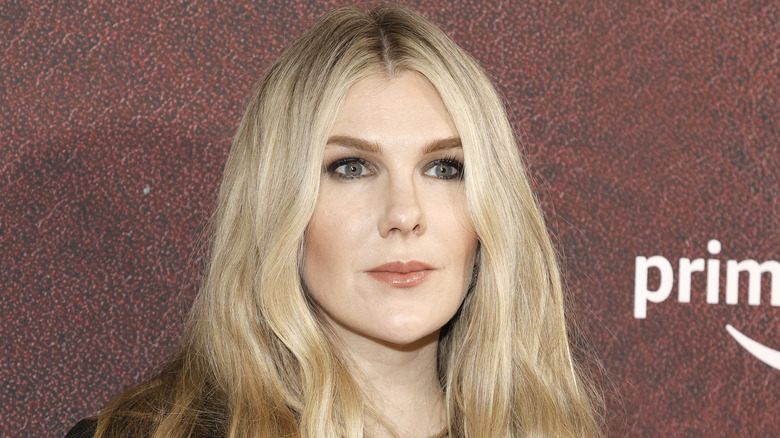The Untold Truth Of The Hunger Games Franchise
It's hard to imagine now, but it wasn't all that long ago that the pop culture landscape was devoid of the "Hunger Games" movies. Before March of 2012, Katniss Everdeen and the other characters of the franchise were confined exclusively to the pages of Suzanne Collins' novels. Once the texts made the leap to the big screen, however, they immediately caught on like wildfire with moviegoers. Rather than resonating exclusively with fans of the books, "The Hunger Games" captured the minds and hearts of a whole new audience — one fascinated by the story's sociopolitical themes and central love triangle. Though the initial series of films has been finished for years now, the influence of "The Hunger Games" continues to reverberate throughout pop culture.
Even with its immense popularity, though, there are still pieces of the franchise's history that most fans may not know about. The secrets of the "Hunger Games" movies include everything from the cost of bringing the books to the big screen to alternate casting choices for key characters like Haymitch. You may think you know everything about "The Hunger Games," but the odds are ever in your favor of finding out something new by delving into the untold truth of the saga.
Lionsgate bought the Hunger Games movie rights for $200,000
The "Hunger Games" series ended up grossing just under $3 billion worldwide, making it one of the biggest film franchises of the 2010s. That's an impressive feat, especially given that the source material was still fresh in the public consciousness. It wasn't a saga getting by on decades of nostalgia, but rather one that resonated powerfully at the moment. As a result, the franchise had no trouble securing sizable box office returns every time it went up to bat.
Given the series' enormous financial victories, it might be surprising to learn how little Lionsgate paid for the film rights. Back in 2008, the studio reportedly shelled out just $200,000 to bring Katniss Everdeen and her comrades to the big screen (per Newsweek). While not chump change, that seems like an impossibly low sum now given the franchise's success. The return on investment wound up being massive, with the eventual box office grosses far exceeding the price paid for the rights.
The intense casting process for Katniss Everdeen
Today, it's nearly impossible to imagine anyone but Jennifer Lawrence playing the lead role of Katniss Everdeen in "The Hunger Games." Not only did she receive significant praise for her performance, but the first film also came out at a pivotal time in Lawrence's career. Her star was rising after her acclaimed turn in 2010's "Winter's Bone" and her debut as Mystique in 2011's "X-Men: First Class," and "The Hunger Games" premiered just months ahead of "Silver Linings Playbook."
In retrospect, it seems like Lawrence was fated to play Katniss, but her selection was far from a sure thing at the time. The casting search for the role spanned far and wide (per EW), with at least 30 different women being considered for the part. Lawrence was a top contender from the beginning, but young stars like Hailee Steinfeld, Saoirse Ronan, and future "Divergent" star Shailene Woodley were also in the running. The process considered performers ranging from ages 14 to 24, and since there was initially no frontrunner, it was open season for young actors. Eventually, Lawrence — hot off her Oscar nod for "Winter's Bone" — would score the role of Katniss, changing her career and the "Hunger Games" franchise forever.
The hunt for the Hunger Games director
While not quite as extensive as the hunt for Katniss Everdeen, Lionsgate's search for a director to helm the first "Hunger Games" was still quite an affair. In September 2010, Deadline reported that the primary frontrunners for the job were Gary Ross, Sam Mendes, and David Slade. Francis Lawrence, who would go on to direct all of the "Hunger Games" sequels, was also considered for the first film, but he was ultimately passed over.
It's easy to see why Lionsgate gravitated toward each of these filmmakers for "The Hunger Games," though they each had vastly different qualifications. Slade, for example, was hot off of helming the third "Twilight" movie, "Eclipse," which had hit a domestic box office high for the franchise. Meanwhile, Mendes didn't have experience directing movies aimed at teens, but his reputation as director of the Best Picture-winning film "American Beauty" would have lent instant prestige to "The Hunger Games." Eventually, though, Lionsgate whittled down the list of prospective filmmakers to Gary Ross — another director who was familiar with awards season thanks to his 2003 film "Seabiscuit." With Ross at the helm, a key part of the "Hunger Games" equation was solved.
John C. Reilly almost played Haymitch
The casting for Katniss, Peeta, and Gale took up much of the media's attention when it came to getting actors assembled for "The Hunger Games," but they were far from the only characters in need of talented stars. One of the most important figures in the whole franchise is Haymitch, a former Hunger Games victor who's a shell of his former self by the time he becomes a mentor figure to Katniss. The part required someone who could be funny while also providing a believable sense of sorrow and trauma from all that Haymitch had experienced. It's a complex part, but also a vital one for the story to work properly.
In April 2011, as "The Hunger Games" was nearing the start of principal photography, Vulture reported that John C. Reilly would be offered the role. A character actor known for working in all genres, Reilly seemed like a great fit. He could deftly handle the comic relief side of Haymitch, and his dramatic performances in films like "Chicago" demonstrated his ability to depict vulnerability as well. However, despite how promising the casting sounded, Reilly didn't end up playing Haymitch. Woody Harrelson was ultimately selected for the part instead and proceeded to reprise the role in all of the "Hunger Games" sequels
Steven Soderbergh worked on the first Hunger Games
Despite their status as big-budget franchise blockbusters, the "Hunger Games" movies have often attracted artsier industry figures, including Steven Soderbergh. Though no stranger to mainstream fare as the director of "Ocean's Eleven," Soderbergh is also the man responsible for movies like "Traffic," "Logan Lucky," and "Bubble." His work can be impenetrable, hysterical, and everything in between, and he generally isn't a name you associate with big action franchises. For the original "Hunger Games" film, however, Soderbergh made an exception.
Talking to Moviefone (via Collider), Soderbergh revealed that he and Gary Ross were longtime friends who'd often "exchanged creative favors" over the years. As "The Hunger Games" was preparing to begin principal photography, Ross called Soderbergh and asked if he'd be willing to shoot two days of second-unit footage for the film, since he wanted someone he knew he could trust. Seeing an opening in his schedule around that time, Soderbergh agreed to the job and proceeded to come on board for the requested two days, adding just a bit of his critically-acclaimed flair to the production.
The quick search for a Catching Fire director
Once "The Hunger Games" became a box-office smash, it was immediately apparent that the other two books in the series, "Catching Fire" and "Mockingjay," would be adapted into feature films as well. Even before the first movie's release, Lionsgate showed its confidence in the franchise by scheduling a "Catching Fire" adaptation for release in November 2013. It was a bold move that demonstrated the high expectations for "The Hunger Games," and it also allowed for a very quick turnaround time for "Catching Fire" to get produced.
Just a few days into the theatrical run of "The Hunger Games," director Gary Ross announced that he would not be directing "Catching Fire" (per EW). He said that the sequel's rapid production schedule didn't give him adequate time to prep the project, so he parted ways with Lionsgate, and the studio quickly got to work finding a replacement director for "Catching Fire." Deadline reported that the competition was quickly narrowed down to two names: Bennett Miller and Francis Lawrence. At the time, Miller seemed like a solid pick, as he'd recently helmed awards season favorites like "Capote" and "Moneyball." Lawrence, on the other hand, was a genre movie journeyman known for films like "Constantine" and "I Am Legend." Eventually, the odds tilted in favor of Lawrence, who ultimately won the gig and went on to direct both parts of the "Mockingjay" adaptation as well.
Michael Arndt's quick timeframe to rewrite Catching Fire
Screenwriter Michael Arndt hit the ground running at the start of his career in Hollywood. His first produced script was "Little Miss Sunshine," which would go on to win him an Academy Award. Right after that, Arndt penned the screenplay for "Toy Story 3," making him two-for-two in critically acclaimed scripts. One of his many gigs after working on the Pixar film was rewriting the screenplay for "The Hunger Games: Catching Fire" — an experience that wound up being a major challenge to pull off.
Talking to The Script Lab, Arndt revealed that the primary issue he faced with rewriting "Catching Fire" was time. Every screenwriter wishes they had more time to write their scripts, but Arndt had the specific challenge of reworking the whole movie just 12 weeks before it began filming. With such limited time on his hands, Arndt needed all the help he could get. Fortunately, co-writer Simon Beaufoy and the rest of the "Hunger Games" creative team were there to provide just that. Through collaboration, Arndt made sure that the screenplay for "Catching Fire" was ready to go in time for the cameras to start rolling.
Filming Catching Fire for IMAX
The original "Hunger Games" ended up proving quite popular in IMAX, to the point that it was given a surprise extended run in the format due to high demand. Apparently, the series had grown into such a pop culture phenomenon that it needed a screen big enough for all the passion the fans had. Given the immense success of "The Hunger Games" in IMAX, it's no surprise that "Catching Fire" was produced with the medium strongly in mind.
Nearly 50 minutes of "Catching Fire" footage was captured on IMAX cameras, with an unprecedented amount being dedicated to one continuous sequence — the games themselves. At the time, IMAX-heavy films like "The Dark Knight Rises" typically featured smaller segments of footage filmed for the larger format, with numerous aspect ratio changes throughout. "Catching Fire" stepped up its game by refusing to break away from the IMAX aspect ratio during the entirety of the games portion of the film. That's the sort of visual flourish you need to deliver on the sky-high expectations "Hunger Games" fans had, and boy did "Catching Fire" deliver.
Three Ed Sheeran songs were rejected for Catching Fire
Ed Sheeran is such a popular artist that it's hard to imagine anyone turning down the opportunity to work with him. He's also had big success contributing songs to feature films like "The Hobbit: The Desolation of Smaug" and "Yesterday." However, Lionsgate actually passed on the chance to work with Sheeran on "The Hunger Games: Catching Fire," rejecting a trio of tunes that he proposed for the film's soundtrack.
In an interview with radio station Click 98.9 (via Digital Spy), Sheeran said that he pitched three original songs for the "Catching Fire" soundtrack, all of which were turned down. Sheeran also noted that he had a similar experience having song proposals rejected for the "Twilight" movies. Despite the setbacks, he said that he still wanted to produce music for feature films as a way of expanding his creative horizons. Of course, given the enormous success that Sheeran's had in the years since "Catching Fire," missing out on the film obviously wasn't the end of the world for the performer. Still, having so many original songs rejected would be a disappointment for anyone, even him.
The reason Mockingjay was split into two movies
It's easy to see why the third entry in the "Hunger Games" book series, "Mockingjay," would be split into two separate movies given the trend of big book adaptations in the 2010s. In an era where the final "Harry Potter" and "Twilight" books were split into two films each and "The Hobbit" spawned an entire trilogy, it makes sense why "The Hunger Games" would follow suit. After all, turning one book into multiple movies means extra opportunities for the studio to milk a viable brand name at the box office.
However, the official reason given by director Francis Lawrence for splitting the "Mockingjay" book into multiple films was to emphasize two disparate tones in Katniss Everdeen's final adventure (via Gizmodo). Lawrence saw the first "Mockingjay" movie as being more "internal" — a quiet but ominous political affair — whereas the second film was a much larger-scale war story. For Lawrence, trying to cram these different aesthetics into one film wouldn't have worked, so he welcomed the opportunity to split the story into two feature films. Of course, the fact that Lionsgate got an extra blockbuster out of this decision was a nice bonus for the studio as well.
The effect of Philip Seymour Hoffman's passing
In February 2014, Hollywood lost an acting legend in Philip Seymour Hoffman. Passing away from a drug overdose, Hoffman left behind a staggering body of work destined to stand the test of time. His death came toward the end of filming on the two "Mockingjay" titles, with Hoffman deep into the production in the role of Plutarch Heavensbee. Since Heavensbee was such a focal point of the books and the "Catching Fire" movie, Hoffman's death had a major impact on the team behind "The Hunger Games."
In the end, only minor changes were needed in the wake of Hoffman's passing (per CinemaBlend). The actor had just two scenes left to film in the second part of "Mockingjay," and all of his material for the first part had been completed. One of the remaining scenes showed Heavensbee meeting Katniss after her third-act imprisonment. In the final cut of "Mockingjay," the scene was changed so that Haymitch visited her instead and read a note written by Heavensbee. It was a bittersweet moment for those watching the film — a clear reminder of Hoffman's absence and the tremendous loss that the world of acting had suffered.
If you or anyone you know is struggling with addiction issues, help is available. Visit the Substance Abuse and Mental Health Services Administration website or contact SAMHSA's National Helpline at 1-800-662-HELP (4357).
Lily Rabe's brief time on Mockingjay
For a brief moment, the cast of "The Hunger Games: Mockingjay – Part 2" included Lily Rabe in the role of Commander Lyme. Being a part of the blockbuster's star-studded cast could have been a big deal for Rabe, but she eventually had to drop out of the production, with Gwendoline Christie taking over the part in the final cut. Such drastic casting shifts in productions as big as "Mockingjay" are sometimes due to behind-the-scenes drama, but according to Rabe, that wasn't the case for her.
Speaking to Collider in 2021, Rabe explained that when she initially signed onto "Mockingjay," she had no scheduling conflicts. However, the shooting dates kept getting bumped up, eventually causing the blockbuster to interfere with Rabe's Shakespeare in the Park production of "Much Ado About Nothing." Given that she'd committed to the play first, Rabe had to drop out of "Mockingjay." According to her, the producers of the film were very understanding and supported Rabe's choice when it became clear she'd have to pick one or the other. Though far from ideal circumstances, there are certainly worse ways to leave the cast of a movie like "Mockingjay."
